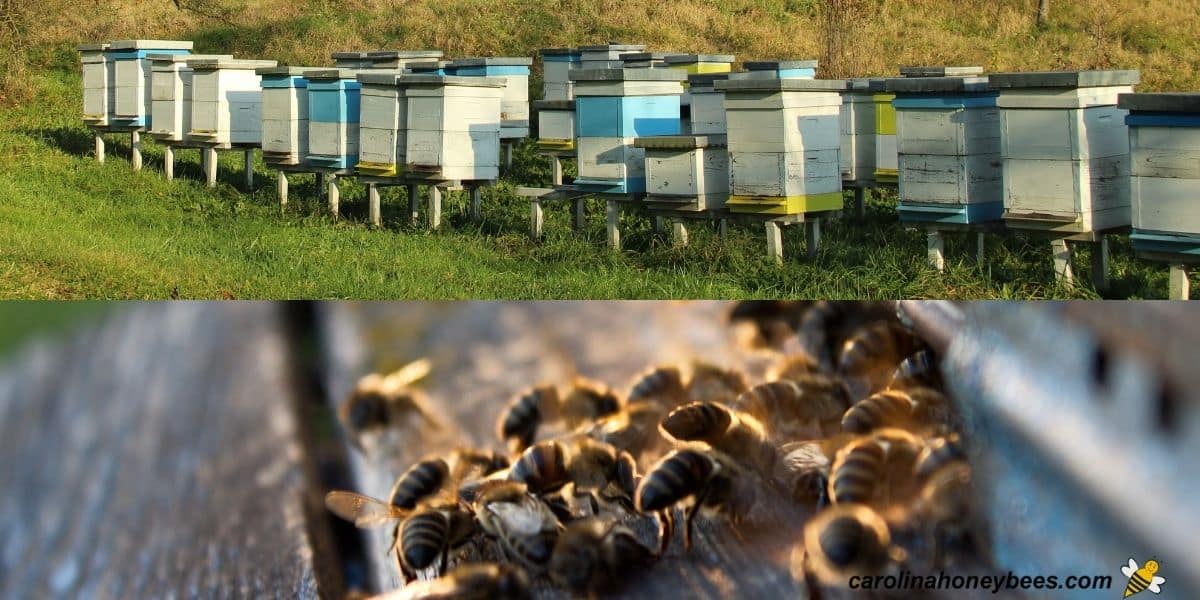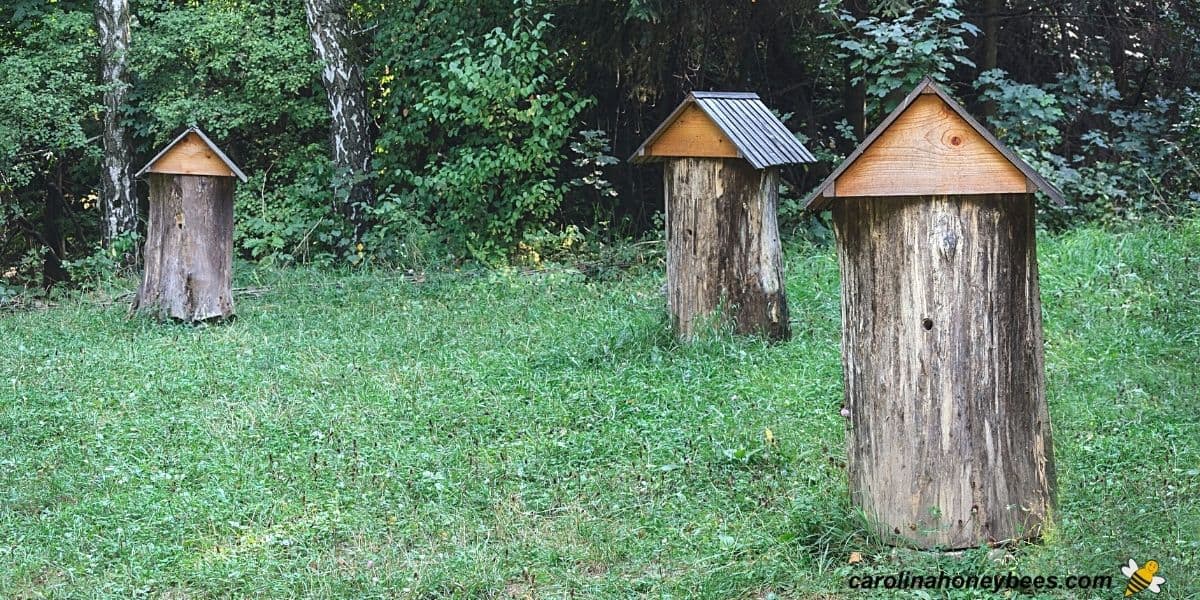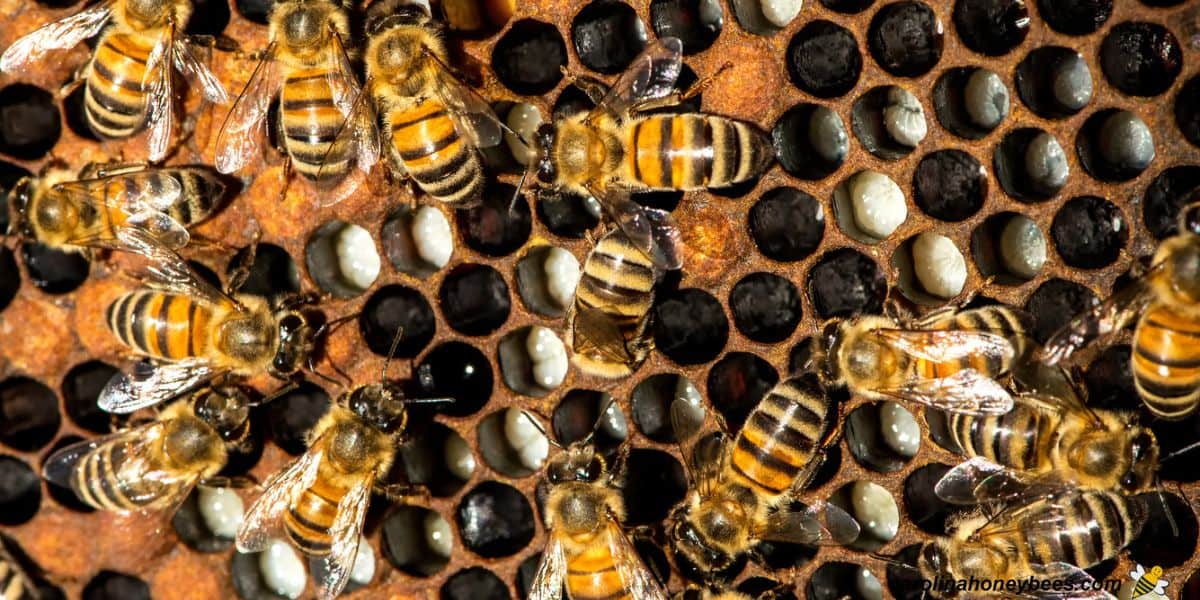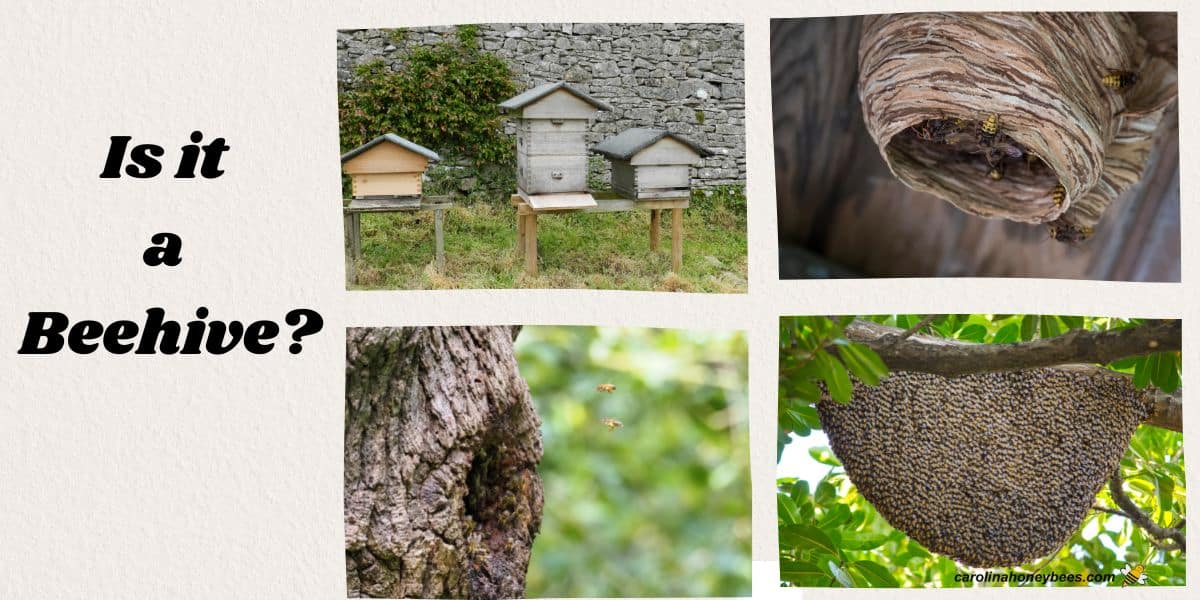What Is A Beehive?
What is a beehive? It is the place a honey bee colony calls home. They may occupy a man-made wooden box, an empty hollow log or other enclosed structure. The ability of bees to find new places to build their hives is truly fascinating. If conditions change or the colony outgrows their current location, they will search out a new hive to call home.

In the wild, honey bees create natural hives in locations that they feel are a good fit. And, even though we will never truly domesticate them – beekeepers build beehives for their colonies in a variety of styles.
A Home for Honey Bees
Specific images may come to mind when you think of a beehive? In the largest definition, beehives are either natural or domestic.
The term “beehive” usually refers to the physical structure a colony lives in. Perhaps, you may buy a beehive – referring to a physical box – like a Langstroth hive built to a standard size.
But sometimes, people use the word beehive to refer to the group of bees that live in a hive – also known as a colony. In this case, you purchase a hive of bees – that may or may not include the physical box.
For the educator or true bee enthusiast, a glass- walled observation hive can serve as a temporary home for the colony.
Not All Honey Bees Use Hives
Not all bees live in cavities or hollow spaces. In some parts of the world, there are species of honey bees that build open nests instead. This is especially true of some of the Asian honey bee species (Apis dorsata and Apis laboriosa).

Apis Mellifera
The species of honey bee in the United States is Apis mellifera – the European Honey Bee (also Western Honey Bee).
Members of this classification build their honey bee nest in an enclosed cavity. This helps them control the heat and humidity while rearing young.
It also aids in protection of the comb, stored food and the area with young bee brood. Exposed comb could allow damage due to bad weather. And, many honey bee predators would be very happy to attack the hive.
A simple view from the outside of a beehive gives no indication of the magic happening inside. In fact, during Winter the hive may seem dead – but the colony is snuggled inside the beehive.
With enough stored food and good health – a honey bee colony can hunker down and live out the cold months until Spring arrives again.
Of course not every hive member makes it to next year, the lifespan of bees varies due to many conditions. But, hopefully some members of the colony survive to carry on the legacy.

Where Do You Find Beehives?
In years past, it was common to find honey bees that have created a beehive in a hollow tree. When a colony lives in a tree, beekeepers in my region of the country call it a bee tree.
In days past, beekeepers would cut out the section of log where the nest was located. After sitting the log on a base and adding a top it was called a “bee gum”. Some of the older beekeepers in the area still refer to all modern beehives as “gums”.
Natural beehives might live in the wild for years and years. Of course, this was more likely before the influx of a honey bee pest known as Varroa Mites.
Mites wiped out most of the feral bee population several years ago. It is still possible to find a bee tree these days, but they are not as common as before.
Also, without a beekeeper that knows when to perform mite treatments – most wild colonies die in a few years.
Not Honey Bees

Not every type of bee that builds a nest in a tree is making a true beehive. Hornet nests are often confused as honey bee hives. They are not – do not try to collect any honey from a hornet nest!
These insect predators serve a useful purpose by catching spiders and other pests. But, they have a nasty temper – stay away. They build a new nest each year and do not overwinter like a honey bee colony.
While it is not impossible, it is very uncommon to find honey bees nesting in the ground. There are many species of bees that live in the ground.
However, the most common one confused with honey bees is a member of the wasp family called – Yellow Jackets. Many homeowners put out the yellow jacket traps to reduce the number near their home.
Yellow Jackets and honey bees share some common characteristics but they are very different. This is another type of nest that you should stay away from as the inhabitants are know for nasty personalities.
Honey Bee Hives in Trees
What about those colonies of honey bees that build in the trees? Some do find an inner cavity to set up housekeeping – it is their natural habitation form.
But, you may find bees on sheets of exposed honeycomb just hanging from a limb. Is this a bee hive? Perhaps not – likely you are seeing a bee swarm. They will eventually move on to a better location.
However, sometimes swarms get stuck and can’t decide where to go next. Those homeless bees that build comb on exposed tree limbs will eventually freeze to death in cold climates. They can not survive the Winter weather. Can a local beekeeping association for help.
Will Beehives in Trees go Away?
In general – no. It is possible that a colony located in a tree cavity will eventually die out due to disease. But, they sometimes live there for years.
However, sometimes you might see what you think is a beehive in a tree – but it is only a round swarm of bees – resting before moving to a new location.
Beehives in Unfortunate Places
Sometimes bees move into structures that conflict with the desires of humans. Homeowners do not like to find a honey bee hive living in the walls of their home.
A good reason to caulk any openings to the outside. Removing honey bees from a house is rather expensive.
Or a colony may move into an empty wood pile or a small plastic utility box. Even an unused gas grill can be home to a colony of honey bees.
None of these situations are ideal – for the bees or the homeowner. It is especially risky for people liking in areas known to have “killer bees”.
This race of bees known as Africanized Honey Bees prefer some of these unusual locations-such as water meters. If you suspect you have Africanized Bees, call a professional for removal – they can be dangerous.

Manmade Beehives
Beyond natural hive locations, there is another common type of bee home. This is a man-made box used by beekeepers. Modern beehives have many parts – this makes managing the colony easier for the beekeeper.
The colony has room to raise young and store food. The top boxes of a hive stack may contain excess honey for the beekeeper. These beehive boxes are often called honey supers.
There are several different types of beehives and their configuration varies (number of boxes uses etc). The most common is the Langstroth hive developed in 1851. It is a favorite of beginner beekeepers.
This hive design features honeycomb held in removable wooden frames. Using the principle of bee space, the design revolutionized beekeeping.
Bee space (commonly referred to as 3/8”) is the space that bees will naturally leave between sheets of honeycomb.
The Langstroth hive boxes and frames were build to specifications that reduced burr comb or bridge comb construction. This made it much easier to check the colony without killing bees.
Those of you wishing to build a hive of your own will want to acquire hive plans or blueprints with the right measurements.

For ease of management, the beekeeper usually keeps multiple hives in one central location. The term apiary is used to describe the bee yard.
Having the hives closer together makes for more efficient bee management. However, placing many hives together increases competition for foraging. We don’t want to place too many colonies in one location.
What Is a Beehive Made Of?
The beehive consists of an outside physical structure that encloses the nest. This material may be a tree trunk, pine wood or even plastic. The covering protects the resources and colony members.
Now for the true heart of the hive. Sheets of honeycomb that contain thousands of individual wax cells. Think of them as rooms in a house – bees use the spaces.
These hexagon wax cells, are built by worker bees. Building comb requires a large population of young bees and a lot of food to fuel the workers. But, this work is necessary.
The colony could not survive without the honeycomb sheets that serve as storage. Worker bees gather nectar and bring it back to the hive. These bees make honey to be used over Winter.
Also, pollen is converted to bee bread and stored until it is needed by the colony. But, it is not just food that you find here.
Some cells are also used to hold developing babies called “brood”. In honey bees, the queen lays eggs – one in each cell. After a few days, bee larvae emerge from the egg.
Nurse bees (worker females) begin the job of feeding the young. These resources represent the future of the entire colony.

To make the beehive draft free and clean, the interior is coated with sticky bee propolis. Propolis is a mixture of plant resins, beeswax and saliva that has anti-bacterial and anti-fungal properties.
An excess of propolis makes hive inspections more difficult for beekeepers. The boxes and frames will seem to be glued together. However, it is thought that more propolis may mean healthier bees.

FAQs
No. Beehives are not normally dangerous. Honey bees are one of the most accommodating bees in the insect world.
However, they do live in large colonies of over 40,000 bees during the Summer. They deserve respect.
Colony temperament will change over the season too. A queen that passes on defensive behavior to her offspring, night time predators irritating the colony or bad foraging conditions can turn the mood nasty.
For this reason, it is important to find the very best place to put your beehives. Away from human traffic, walkways or play areas is the best plan.
Sometimes, you may find a hive of wild bees living in a tree or building.
Honey bees are not normally aggressive when left alone. Leave them alone. Do not approach the front of the entrance or get too close.
Yes, you can often keep bees in neighborhoods. The first step is to check your local laws and regulations.
Many locals allow beehives with some restrictions such as a minimum number of hives or having to own a certain amount of property.
Being a good beekeeping neighbor will go a long way towards the acceptance of your beehive.
In addition to good placement, don’t work your bees on the same afternoon your neighbor is having an outside birthday party.
Is there a neighborhood pool? Provide a water source for your bees before they arrive and you have to decide how to keep bees away from a swimming pool. Common sense goes a long way.
Honey bees are a bit different than most other types of bees. Most bees do not over winter as a colony.
For these bees, a mated queen hibernates in leaves, bark and forest debris. Next Spring, she emerges and starts a new nest. That is why you do not see large nest early in the season.
Honey bees however are social insects. The whole bee family over-winters. Bees survive winter by clustering together for warmth and eating honey stored for this purpose.
So, a beehive may look empty but hopefully there is a cluster of bees in there – waiting for Spring.
They can be. Beekeeping is a wonderful hobby. However, if you are looking for an easy way to make money, I would look elsewhere.
Honey bee colonies are prone to failure from many stresses. If you are seeking to start a beekeeping business, I suggest you begin slow and grow your number of hives as you learn.
Must you have a location with full Sun for a hive? No. Beekeepers who live in regions where the Small Hive Beetle is found should avoid full shade. Beetles reproduce more easily in moist, shady soil.
If you live in one of the hotter regions, some afternoon shade may be very beneficial to your honey bee colony. Placing your beehive in partial shade can help them cool the hive.
If you live in a region with bears, you should be concerned about your bees. Many beekeepers share land with bear families and have no problems.
The installation of a good electric fence for bear control is the first step to harmonious cohabitation.
It is much easier to prevent bear problems that to stop them once started. It is unlikely that a beehive will call a bear in from a great distance.
However, bears roam and you may have one passing through who knows how good bees taste!
Honey bees contribute a great deal to our agricultural system by providing pollination of crops. Their large colonies are easily moved from one location to another.
However, honey bees have not proven themselves to be the best pollinators for greenhouses. They just want out! Bumble Bees are a better option for large greenhouse pollination.
Oh my, as wonderful as honey bees are, they sometimes establish homes in undesirable locations. A beehive in your home is not good for you or the bees.
Pest control companies will often kill the colony but I would only suggest that as a last resort.
If you find a beehive that needs removal, contact a local beekeepers association. Each state has them and you can contact your state agricultural department if you don’t know who else to contact.
If you have a colony in between the walls of your home, be prepared to pay for bee removal. It is a big job to removed siding etc, and then fix it back to the homeowner’s satisfaction.
Yes, they smell good. Seriously though, beehives do not smell bad unless the bees are dealing with disease. If your beehive smells bad, you need to check for disease.
Not at all, your beehives do not have to be white. They can be painted different colors and your can decorate your hives with painted designs. In many regions, we do recommend light colors to help protect the colony from over-heating.
It sure can and that is a wonderful thing. It is not uncommon for a beekeeper to have a bee swarm move into an empty bee box! Can you say – FREE BEES !
Yes, beehives are living things. Because of the social structure of a honey bee family, a colony is consider a “super-organism.
Each bee goes about its daily tasks – however, the hive as a whole organism can grow and prosper or become weak and die. The combined efforts of the social insect known as honey bees make this possible.
Honeycomb is a wax structure built by bees. Several sheets of honeycomb make up the interior of the hive but a “hive” is generally considered to be an enclosed colony.
Final Thoughts
The beehive is a dwelling place for bees and everything located inside. It may be a hollow trunk of a tree or a man-made box.
Beehives are where the magic of the bee world shows off its best efforts. This industrious little insect fights to survive against all odds in the big wide world. Learn more fun bee facts.

